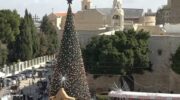A Palestinian woman reacting after her family home was reduced to rubble, destroyed by Israeli bulldozers.
Khan al Ahmar is just the latest and most prominent in a long pattern of dispossession, demolition, and ethnic cleansing of Palestinians. Israel has since its inception used cruel, racist laws and regulations to “legally” expel Palestinians from whatever land is needed for the Zionist project.
by Kathryn Shihadah, Palestine Home
The world actually paid attention for a while to the recent travesty being perpetrated on Palestinian Bedouins of Khan al Ahmar. The beleaguered village was a heartbeat away from demolition (it still is, actually) when international pressure caused the very court that had authorized the destruction of the village abruptly issued a temporary injunction.
On 11 July, this court will supposedly rule, once and for all, whether Khan al Ahmar is to be turned to a pile of debris.
The village of Khan al Ahmar is in the occupied West Bank, and is under total control of Israel. When Palestinians apply for building permits from Israel, it can take years to get a response and cost tens of thousands of dollars, and 98.5% of applications are rejected.
The residents of Khan al Ahmar are repeat refugees: in 1948-49, when 750,000+ Palestinians were ethnically cleansed from the newly minted land of Israel, the Jahalin Bedouin tribe was among the few people groups to stay behind. Israel expelled them in the 1950s, and they made their way into Palestinian territory in the West Bank. They were removed again by Israel in the 1970s to make room for an illegal Israeli settlement. That settlement has expanded, and the Bedouin are again in the way. Hence the demolition orders for the village.

Khan al Ahmar’s Bedouin residents have an almost irresistible option: Israeli authorities have offered them a new location on which to live. It is next to a garbage dump and an IDF camp.
If this sounds like insanity – it is. If it doesn’t sound like insanity, keep reading – it will. Or, if it doesn’t, get yourself to a hospital and ask someone to check you for a pulse.Khan al Ahmar’s Bedouin residents have an almost irresistible option: Israeli authorities have offered them a new location on which to live. It is next to a garbage dump and an IDF camp.
If this sounds like insanity – it is. If it doesn’t sound like insanity, keep reading – it will. Or, if it doesn’t, get yourself to a hospital and ask someone to check you for a pulse.
Khan al Ahmar is not an aberration, except possibly for the fact that it is (temporarily) being spared.
Here is just a sampling of incidents in the last few weeks.
Most recent wreckage
On Wednesday 4 July, Israeli forces demolished 9 homes and 3 agricultural buildings in the Palestinian village of Abu Nuwar. 62 people were rendered homeless.

On Tuesday 26 June, Israeli forces destroyed roads leading to farmland in the village of Issawiya. This is part of an unfolding plan by Israel to build a national park where Issawiya now stands.
Also on Tuesday 26 June, Israeli forces destroyed a parking garage in Silwan. The structure had already been partly demolished by its owners to avoid paying the demolition fee of $15,000.
On Monday 25 June, in the town of Hizma, 4 commercial buildings, which housed 20 Palestinian businesses, were destroyed. The owners of the buildings stated, “This is the 5th time that these buildings have been demolished…Rebuilding is a necessity since it is [our] only source of financial support.” 5 homes in Hizma have also been served demolition orders for allegedly lacking construction permits. These homes are 40-50 years old.
Also on 25 June, at least 2 other families in East Jerusalem began to demolish their own homes in order to avoid the $25,000 fee that the Israeli municipality would charge them for demolition “services.”
On Wednesday 20 June, Israeli forces demolished a home in Qalandia, in spite of the fact that its owner had a court order halting the demolition.
In addition to these incidents, ICAHD reports demolitions of approximately 30 other structures and 4 village in the month of June 2018 alone.

Once in May and at least 3 times in June, the entire Palestinian village of Khirbet Humsah was served with “temporary evacuation orders.” All 16 families – including many children, an infant, and a child with Down syndrome – were required to leave their homes for the day so that military training could take place in the area. They were sent to an unsheltered area for the day, in spite of the fact that it was summer and they were observing the Ramadan fast.
Khirbet Humsah and 11 other communities, totaling 1,300 residents, are located in military training “firing zones.” The training often includes live ammunition and dozens of tanks and armored vehicles.
Also in May, Israeli forces demolished a newly paved road, affecting 3,800 residents in the West Bank, and 6 homes near Hebron, leaving 26 residents (8 of them minors) homeless. They also destroyed livestock pens and water tanks, and confiscated solar panels.
A 70-year pattern
Home demolitions began with the onset of the occupation in the West Bank and Gaza, and the (mostly unrecognized) annexation of East Jerusalem, in 1967. Since then, nearly 50,000 Palestinian homes, multifamily apartment buildings, and other structures have been demolished. Hundreds of thousands of Palestinians have been displaced; an unknown number of families have lost their means of sustenance. The costs involved in rebuilding, relocating, and recreating stability have no doubt prohibited many families from sending children to college, paying for needed medical procedures, or even emigrating to escape the occupation.
At the same time that Palestinian homes are disappearing in the West Bank and East Jerusalem, Israeli homes are popping up. About 750,000 settlers live illegally in the occupied Palestinian territories.

Interestingly, only 15% of East Jerusalem – the “Arab” part of Jerusalem – is zoned for residential Palestinian use (yes, residential zoning is race-based), although 40% of the city’s population is Palestinian. Israel does not leave room for natural growth of the Palestinian community in their own city, nor does it permit them to build on their own land.
But even farther back, in 1947 and 1948, after 80% of the Palestinian population had fled or been forced to leave their homes, and 600 (six hundred) Palestinian villages were demolished – about 2/3 of them before the State of Israel was created.
 In order to make the land officially Israeli, the new Israeli legislature created new laws (or appropriated very old laws), such as the Absentee Property Law. Through this legislative slight-of-hand, Palestinians who had fled from their homes were first barred from returning to their property. Then the Israeli government chose a day and declared that anyone not in their homes on that day was legally “absent.” Even those who held their deeds in their hands and were within view of their homes on that day were out of luck. The official title for the 50,000 Palestinians in this predicament: “present absentees.” Once these hurdles were cleared, the formerly-Palestinian homes could be demolished or repurposed for Jewish use.
In order to make the land officially Israeli, the new Israeli legislature created new laws (or appropriated very old laws), such as the Absentee Property Law. Through this legislative slight-of-hand, Palestinians who had fled from their homes were first barred from returning to their property. Then the Israeli government chose a day and declared that anyone not in their homes on that day was legally “absent.” Even those who held their deeds in their hands and were within view of their homes on that day were out of luck. The official title for the 50,000 Palestinians in this predicament: “present absentees.” Once these hurdles were cleared, the formerly-Palestinian homes could be demolished or repurposed for Jewish use.
Under the Prescription Law, farmers were required to prove that they had cultivated their land, uninterrupted, for a period of 15 years. If they were unable to do so, the land reverted to the State. This was problematic for many reasons, not the least of which was the fact that some of the Palestinian farmers’ documents had been lost in the war or during their evacuation. Some tried to use tax records as proof, only to have that form of documentation rejected.
Thus, the 750,000 Palestinians who had fled from their homes during the war found themselves permanently displaced.
In Israel’s 70 years of existence, the total number of home demolitions has reached well over 100,000, and the number of Palestinians displaced to perhaps 1 million or more.
How does it work?
Israel has full military and civil authority over 60% of the Palestinian West Bank, and considers East Jerusalem to be part of the “eternal, undivided capital of Israel” – although the UN, the EU, as well as a large number of countries and international organizations consider the annexation of East Jerusalem to be illegal.
The government of Israel is fully invested in the practice of home demolition. Even the Supreme Court is compliant with the unjust practice. In 2004, it provided a handy loophole so that the work can be done unhindered and often without warning: it allowed for demolition to occur without warning and without due process if advance notice would hinder demolition.
Israeli authorities offer various reasons for demolishing Palestinian structures,
– Israel declares land on which Palestinians have built homes to be “agricultural land” or “open green space,” or decides to create a national park or archeological dig;
– Palestinian property owners have no permit for recently constructed buildings (see above);
– the slope of their land is judged as “too steep” for a home;
– a house is too near a settlement or an Israeli-only highway (although the houses were there first – and yes, there are separate roads for Israelis and Palestinians);

– as collective punishment for some action – often when a family member is convicted (rightly or wrongly) of a serious crime, his/her family’s home is demolished (although Israel has refused to demolish family homes of Jewish criminals – yes, there are separate laws for Jewish and non-Jewish criminals);
– the “clearing” of land for military/security purposes (20% of the West Bank is “closed military zone,” although Israel has plenty of land on which to conduct training exercises, and would have no need of “security” if there were no illegal settlements);
– the expansion of roads, settlements and the “Separation Barrier”;
– “clearing space” to make safe passage for settlers;
– And more.
Case study: Wadi an Na’am
In 1947-48, when most Palestinians fled the war, 11,000 Bedouins remained inside what would come to be known as Israel. That population has now grown to about 200,000.
Of those still living in the Negev desert, about half live in towns assigned to them by the Israeli government – much like Native American reservations in the US – and the other half live in unrecognized villages.
The Bedouin are Israeli citizens, but their villages are not recognized by the state. Consequently, they have no access to basic services such as water, electricity, telephones, sewage systems, and roads.
One such unrecognized Bedouin village is Wadi an Na’am. It has existed quietly near the mostly-Jewish city of Be’er Sheva since the 1950s, its people having been expelled from other parts of Israel after the 1948 war.
Although Israel also built an electric power plant within view of the village, and with high voltage wires running directly above it, Wadi an Na’am and the other 45 or so unrecognized villages are not allowed to access the electricity.

In the 1970s, Israel built the Ramat Hovav industrial zone within the borders of Wadi an Na’am. The zone includes chemical factories, as well as Israel’s only toxic waste disposal facility, and emits bad odors and cancer-causing chemicals into the soil and the water. From the start, the facility has had frequent accidents and explosions; consequently the Bedouin community has experienced birth defects and long-term health problems.
Wadi an Na’am is also surrounded by military firing zones, in which the IDF perform drills with live ammunition. Soldiers often leave behind unexploded shells.
Last but not least, a cluster of new munitions production plants are being built next to the village. The complex will include a testing area for weapons systems, manufacturing facilities for shells, missiles, and rockets, and chemical and explosives laboratories.
It would appear that the most logical response for the residents of Wadi an Na’am would be to simply move away. But these Bedouin see a bigger picture than we who look from thousands of miles away, from our places of comfort.
The villages under the most intense pressure to move are those which would give Israel the greatest benefit. Israel’s leaders have a plan, as well as the patience and funding to carry it out. Strategic placement of settlements will, and in many ways already has resulted in an Israel so dominant, and a Palestine so fractured, that the end of the story is a given.
 This series of maps demonstrates how illegal Israeli settlements have encroached on Palestinian land, and how little is left. Of course Palestinians must resist the demolition of their homes and villages. We in the West don’t know what it’s like to be near extinction as a people and the urgency of the struggle.
This series of maps demonstrates how illegal Israeli settlements have encroached on Palestinian land, and how little is left. Of course Palestinians must resist the demolition of their homes and villages. We in the West don’t know what it’s like to be near extinction as a people and the urgency of the struggle.
Jewish Holocaust survivors should see their story in the Palestinian plight: the cornering, the demonization, the relentless pursuit, the nearness to extinction.
Palestinians don’t need to be reminded to “follow the rules” and apply for building permits – the rules are racist and wrong and need to be changed.
Palestinians don’t need to be told to “just move and move on,” as though persistence in resistance is foolish – expulsion is racist and wrong and needs to stop.
And Palestinians certainly don’t need to be judged as deserving of elimination because of “rockets” or “Hamas” or “Sbarro” – ethnic cleansing is evil and needs to never happen again.
Outrage is the appropriate response. Outrage and action. Everyone needs to know this is happening, and then we need to vote.








